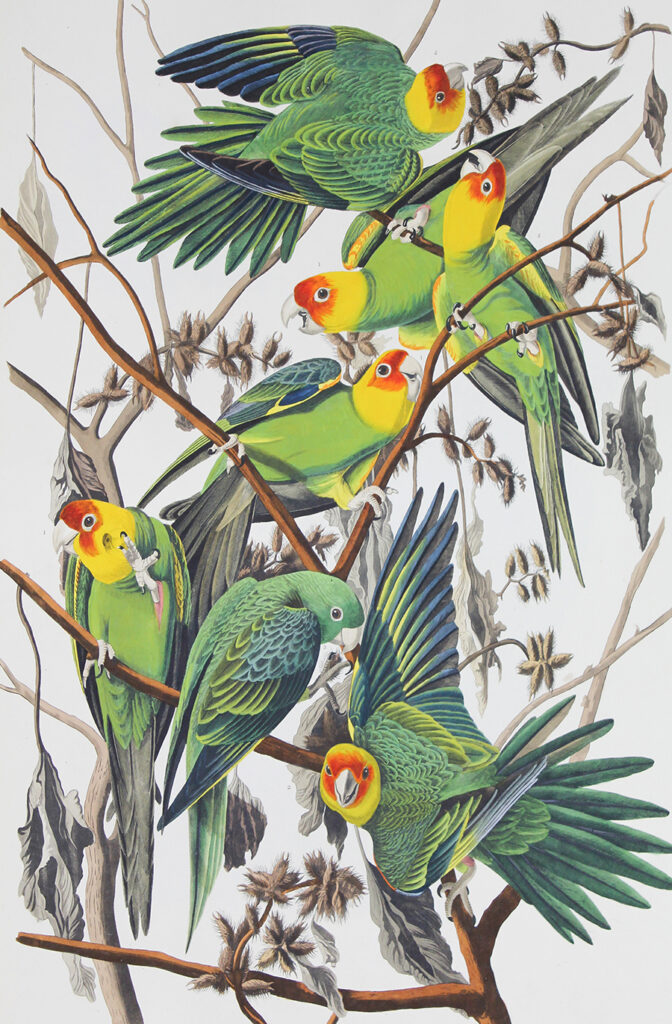Exhibition Explores Printmaker Who Brought Audubon’s Vision to Life
University of Wisconsin’s Chazen Museum of Art Examines Collective Effort Behind the Famous Folios in Seeing Audubon: Robert Havell, Jr. and The Birds of America

Detail of Carolina Parrots from The Birds of America, John James Audubon
MADISON, Wis. – Before John James Audubon’s The Birds of America became one of the world’s preeminent records of natural history, there was the matter of printing this incredible ornithological study. The lengthy and laborious process—which took more than a decade—was taken on by Robert Havell, Jr., an engraver and printer in London.
This early 19th-century collaboration is the subject of the exhibition Seeing Audubon: Robert Havell, Jr. and The Birds of America, which examines Havell’s incredible printmaking techniques and uncovers the dynamic, but underappreciated, collective effort to expand Audubon’s reach through the creation of crisp, beautiful copies of his illustrations. The exhibition is at the University of Wisconsin’s Chazen Museum of Art from Dec. 20, 2021 to April 3, 2022 in the Leslie and Johanna Garfield Galleries.
“For fans of Audubon, this is an incredible opportunity to peek behind the curtain at a partnership between artist and printmaker that created a legendary work,” said Amy Gilman, director of the Chazen. “It often takes many people to execute a creative vision, but art history can obscure these collective efforts in the focus on the artist alone. We’re interested in taking time to pay homage to process, and to gain a deeper understanding of the master printer, Robert Havell, Jr., who painstakingly brought these watercolors to life.”
The exhibition is one of two celebrating printmaking in conjunction with the 50th anniversary of the annual Southern Graphics Conference International (SGCI), which will take place in Madison, Wisconsin, March 16-19, 2022. In addition to Seeing Audubon: Robert Havell, Jr. and The Birds of America, the Chazen will also present Pressing Innovation: Printing Fine Art in the Upper Midwest, from Feb. 14 to May 15, 2022.
This presentation of The Birds of America challenges the perception of Audubon as a singular force apart from the history and culture of printmaking. Rather, the exhibition suggests that Havell’s mastery of technique imparted some of the scientific acumen that underlies the images. He engraved and printed the four volumes between 1827 and 1838 in a detailed process that involved tracing and etching more than 400 mixed-media watercolors into copper plates. In doing so Havell transformed the original watercolor studies Audubon made during his travels documenting birds throughout the eastern United States, resulting in one of the finest works of colored engraving with aquatint in existence.
“Havell came from a line of printmakers—in fact, when Audubon approached the family about the project, Havell’s father knew it was too enormous to do without the help of his son. They reunited to take on this project of ten-plus years together,” Gilman said. “This printing process requires the highest attention to detail, and care, time and space—once that context is better understood, the absolutely outstanding achievement of Havell, Jr. becomes clear.”
The exhibition features two of the four double-elephant folios from The Birds of America, the volumes named for their unprecedented large paper size. Drawn from the Chester H. Thordarson Collection in University of Wisconsin–Madison Libraries’ Special Collections, the volumes will be displayed with an investigation into Havell and his family’s contributions to the history of intaglio printmaking, the first exhibition of its kind.
Alongside the two volumes, this exhibition will feature one of Audubon’s watercolor studies, drawn from the Chazen Museum of Art collection, examples of other prints published by the Havell family, and experimental prints made by Emily Arthur, associate professor in the UW–Madison art department.
This exhibition was conceived by Arthur along with Curator of Special Collections at Memorial Library Robin Rider, Ph.D., and produced with the assistance of project assistant and art history graduate student Katherine Gallman.
“We’re proud to be partnering with the University of Wisconsin and the Madison community to host SGCI’s golden anniversary,” Gilman said. “In honor of the occasion, we look forward to showcasing some of the most inventive printmaking to celebrate their legacy.”
# # #
About the Chazen Museum of Art
The Chazen Museum of Art makes its home between two lakes on the beautiful campus of the University of Wisconsin–Madison. Within walking distance of the state capitol, it sits squarely in the heart of a vibrant college town. The Chazen’s expansive two-building site holds the second-largest collection of art in Wisconsin, and at 166,000 square feet, is the largest collecting museum in the Big 10. The collection of approximately 23,000 works of art covers diverse historical periods, cultures and geographic locations, from ancient Greece, Western Europe and the Soviet Empire to Moghul India, 18th-century Japan and modern Africa.
For more information: chazen.wisc.edu
About SGCI
Founded in 1972 by Boyd Saunders and a group of artist-educators who gathered in New Orleans, SGCI today includes over 1,000 members from around the world. Its annual gathering is the largest printmaking conference in North America. International members of SGCI regularly travel to the conference from Canada, South America, Central America and Europe. In 2022 SGCI celebrates 50 years of connecting artists, students, educators and professionals in the field of original prints, drawings, artist books and handmade paper.
 For more information about the 2022 conference, please visit:
For more information about the 2022 conference, please visit:
https://www.sgcinternational.org/2022-madison/
# # #